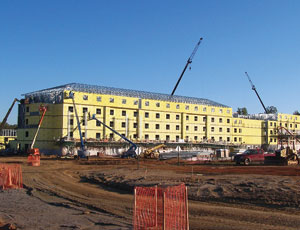The year 2009 marked the midpoint and high-water mark in a seven-year-long flood of work at the U. S. Army Corps of Engineers, with $27.7 billion in construction on the military-programs side and $15.6 billion on the civil-works side. Its leaders say the Corps is able to keep up and improve delivery in large part through implementation of a program called MILCON Transformation.

Maj. Gen. Merdith W.B. “Bo” Temple is credited with being the teeth behind MILCON Transformation, which was developed at headquarters when the pipeline of anticipated work began to bulge in 2004. It established centers of design standardization for many facility types in Corps districts around the country and used “adapt-build” to localize designs for construction. It makes extensive use of design-build and leverages economies of scale in base development.
“It’s very important, and he drove it,” says Mike Rossi, a retired colonel, former commander of the Corps’ Kansas City district and now chief operating officer of construction management firm Vali Cooper International LLC, Madisonville, La. “He was running that operation when they came up with MILCON Transformation, for how they were going to handle triple the amount of work. He had to pitch it to Army staff, make sure it was the right thing to do and make sure the bureaucracy didn’t get weak in the knees.”
Until 13 month ago, Temple bulldogged the initiative as deputy commanding general of military and international operations. Now, although he has a new assignment as deputy commanding general for civil and emergency operations, the initiatives he implemented continue not only in military construction but are affecting civil works as well.
Temple says his initial orders, from then commander Lt. Gen. Carl Strock, were to “get out there and get after it,” he says. “We had a belief that we could save 30% in time and 15% of cost.”
“He truly transformed the military construction program,” says Strock, now retired and a project director with Bechtel Corp., San Francisco. “Without his initiative, the Corps might have been swamped by the huge growth in the program over the last few years.”
If MILCON Transformation is a formula to improve efficiency of design and construction, foster collaboration with industry and get $73.2 billion worth of work done between 2006 and 2013, insiders say Temple was its catalyst. “He was a relentless, positive driving force against a really bureaucratic system and inertia,” says Maj. Gen. Gregg F. Martin, commander from 2004 to late 2007 of the Corps’ Northwestern division in Portland, Ore. “There’s no way the Army could have gotten this built using old systems.”

Temple led application of MILCON Transformation that is helping the Corps meet $73-billion demand for construction over seven years.
Temple is quick to share the recognition, give credit to the team and say his contribution is in the past, but it is clear the development, benefits and influence of MILCON Transformation continue. “I think the USACE, is transforming how it does business,” Temple confirms.
In many presentations that were given as the program took shape, “No one had all the answers on how MILCON Transformation is going to be done or turn out,” admits Temple. But such uncertainties were not going to stop the Corps from going after it anyway. “We told our industry partners, as you practice and learn lessons, you’ve got to share them, and we will adjust fire as we go,” he says.
Now, civil works is borrowing from MILCON Transformation by using design-build, says Temple. “The largest design-build project in the history of the Corps is a civil works project—a $1.3-billion surge barrier,” he points out. “It’s not unlike MILCON Transformation. We gave the contractor performance expectations and a 5% concept of what were looking for, and he designed and built every bit of the rest of it—or at least he is finishing the building of it—himself.
“I don’t feel like I did all that much myself, but certainly the folks in the field and in the industry have gotten a lot done with MILCON Transformation in the past few years,” adds Temple. “A lot of hard work has gone into getting this done.”


Post a comment to this article
Report Abusive Comment